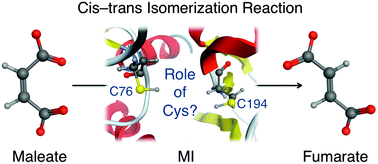Computational investigations on the catalytic mechanism of maleate isomerase: the role of the active site cysteine residues†
Abstract
The maleate isomerase (MI) catalysed isomerization of maleate to fumarate has been investigated using a wide range of computational modelling techniques, including small model DFT calculations, QM-cluster approach, quantum mechanical/molecular mechanical approach (QM/MM in the ONIOM formalism) and molecular dynamics simulations. Several fundamental questions regarding the mechanism were answered in detail, such as the activation and stabilization of the catalytic Cys in a rather hydrophobic active site. The two previously proposed mechanisms were considered, where either enediolate or succinyl-Cys intermediate forms. Small model calculations as well as an ONIOM-based approach suggest that an enediolate intermediate is too unstable. Furthermore, the formation of succinyl-Cys intermediate via the nucleophilic attack of Cys76− on the substrate C2 (as proposed experimentally) was found to be energetically unfeasible in both QM-cluster and ONIOM approaches. Instead, our results show that Cys194, upon activation via the substrate, acts as a nucleophile and Cys76 acts as an acid/base catalyst, forming a succinyl-Cys intermediate in a concerted fashion. Indeed, the calculated PA of Cys76 is always higher than that of Cys194 before or upon substrate binding in the active site. Furthermore, the mechanism proceeds via multiple steps by substrate rotation around C2–C3 with the assistance of the now negatively charged Cys76, leading to the formation of fumarate. Finally, our calculated barrier is in good agreement with experiment. These findings represent a novel mechanism in the racemase superfamily.


 Please wait while we load your content...
Please wait while we load your content...